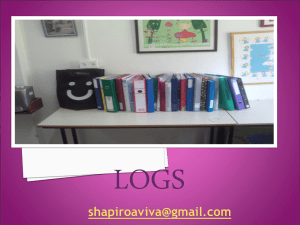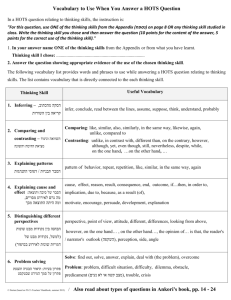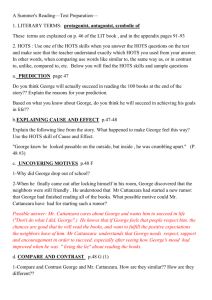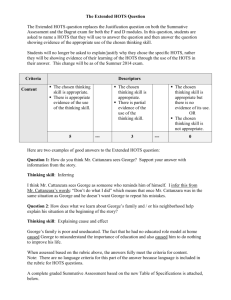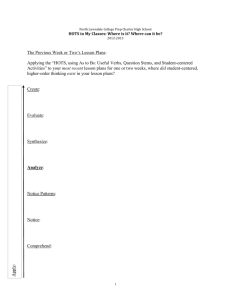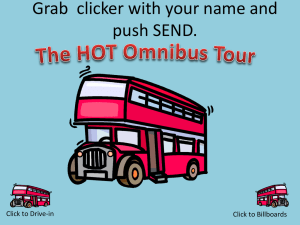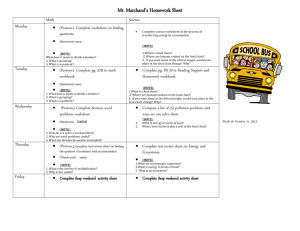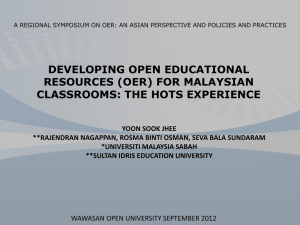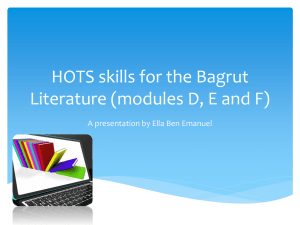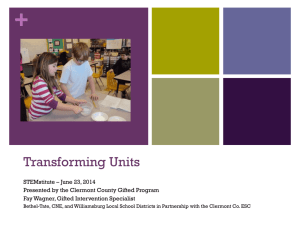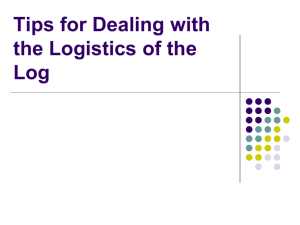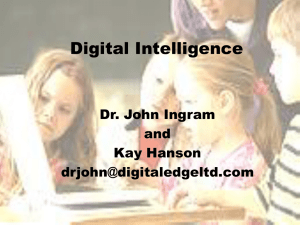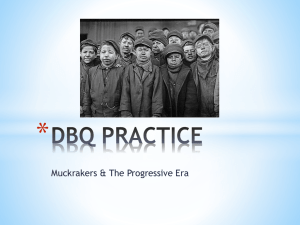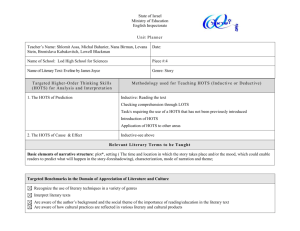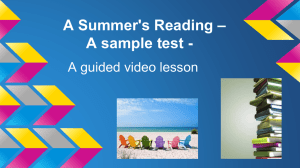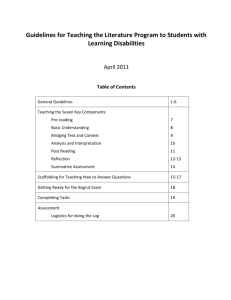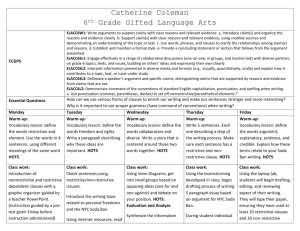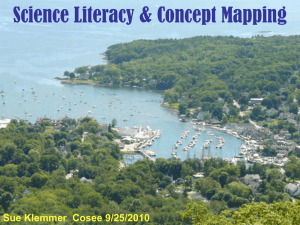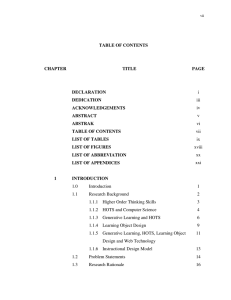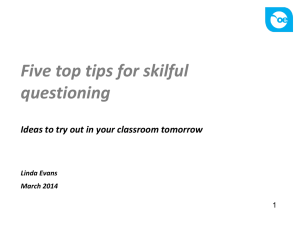Need to remember???
advertisement
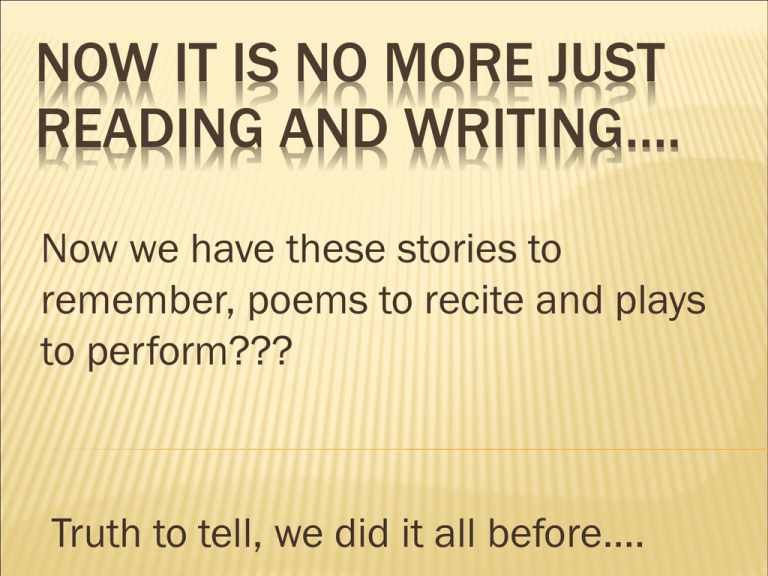
NOW IT IS NO MORE JUST READING AND WRITING…. Now we have these stories to remember, poems to recite and plays to perform??? Truth to tell, we did it all before…. REED Study Day CHANNUKA 2010 LITERATURE PROGRAM + Students with learning disabilities + teaching it LD 7 wonders Teaching abilities and successes A FEW WORDS ABOUT THE COMPUTERIZED BAGRUT… …we may actually be st joining the 21 century!!! בחינות הבגרות המתוקשבות שבנדון נותנות מענה הולם לתלמידים הזכאים להתאמות האלה :השמעת שאלון הבחינה, הקלטת תשובות הנבחן ,בחינה בעל-פה ,שאלון מוגדל או צירוף שלהן. במועדי קיץ תשע"א יפעיל משרד החינוך בחינות בגרות מתוקשבות באנגלית - מותאמות לנבחנים הזכאים להתאמות בדרכי ההיבחנות. הבחינות יתקיימו בשאלונים: THE EXAM WILL BE FOR: Eventually man power pressures will be relieved. More students will be more independent. Joint responsibility. Grading of oral exam will be done. Life long….. skills or at least for the next few years. CHALLENGING BECAUSE: 1. 2. 3. 4. 5. Only one matkonet will be sent. Teachers will have to learn the computer skills and offer practice time. It’s yet another new project. Need enough computers. Need critical mass. HIGHLY RECOMMENDED: Help will be available. Guidance to the schools who choose to join. Guidance from Matach and the LD department. Something new. Participants will be very important in the decision making process. FOR MORE INFO: Ask Avi, or ask me or ….. ….and now back to where we started from! LD 7 wonders Teaching abilities and successes Literature program and the necessity of teaching literary pieces, connecting them to HOTS and taking ownership using the seven key components of : Pre-reading Basic understanding Analysis and Interpretation Post-reading Bridging Text and Context Reflection Summative Assessment GIVENS!!! AND… in the logs and on the test… all there, lots of ways to do it…. GOOD READERS: Make Connections Visualize Infer Determine Importance Synthesize Then they remember! PEOPLE WITH LEARNING DISABILITIES Do not necessarily do those things when reading. Need to remember that our seven key components rely on those abilities. Since they are not automatic when reading in general and in English in particular- our students… ( those with diagnosed learning disabilities and many of our 4 pointers) need activated assistance in those areas. THE ADAPTED LITERATURE PROGRAM Has lots of ways to do that, using diagrams, and graphic organizers and ideas, and the like … for example: Unit Graphic Organizer or: UGO Hand Organizer THIS PROGRAM IS DIFFERENT BECAUSE: We are asking ourselves, to teach our students material to REMEMBER!!!!! On the test, and the summative assessment activities we will be asking the students to remember!!! To remember, there must ownership! Ownership requires understanding. Understanding requires varied ways for accessing the information. AND! Being able to produce known knowledge by…. …understanding what the requirement is. …knowing how to organize the information. …connecting directly to the question or the task. REMEMBER: WE :NEED to be flexible and creative and bridge between the known and the less known and the unknown HOTS: need to be actively, explicitly and frequently taught and reviewed – before, or during ……… while connecting to reality as well as the literature Review, recycle and reenter…. EVERYTHING! MAINTAIN ACCESSIBILITY SO…. the answers can be found the terminology easily accessible so the students can move beyond the HOTS and into the mind the heart and the soul. That is the magic of literature!!! HIGH INTEREST HELPS! Encourages reading Sparks interest, curiosity and thinking Leads to enjoyment of the text and the task Makes lots of things possible Helps to achieve ownership and a sense of success!!! WE HAVE TO LIKE THE LITERATURE WE ARE TEACHING. IT ALSO HELPS IF WE ADMIRE THE AUTHOR. EXAMPLES: Describe the relationship between Mr. Cattanzara and George in the beginning of the story. Need to know??? Need to remember??? Need to understand??? What does Mr. Cattanzara usually do after work? HOTS What did Mr. Cattanzara mean when he said to George: “Do not do what I did” ??? Thinking skill I chose: Explain why: What needs to be automatic knowledge? HOTS What can they think about, and figure out? The more comfortable they feel, the better. What is the question really asking? Need to know: a. Distinction between Mr. C and George b. Same and different c. What did Mr. C do and when? and…. THE STUDENTS NEED TO FEEL COMFORTABLE WITH ENOUGH HOTS IN CASE THEIR MEMORY FAILS THEM AND THEY CANNOT REMEMBER THE ONE THEY LEARNED. In other words: they need to know the HOTS: to know their meanings in Hebrew to actively repeat to connect to specific characters to connect to actions to connect to occurrences to connect to sayings to connect to experiences WE HAVE TO FAMILIARIZE OURSELVES AND OUR STUDENTS WITH: models and examples, of test questions. how to understand what the question is asking what the students need to know to answer the questions what they need to remember what they need to understand… CONTACT! REMEMBER THE SECOND HALF …. Thinking skill I chose: Explain why? LETS SAY………….. Choose a HOTS: Inferring Then forget what it is….. Then waste time looking it up in the electronic dictionary…. Get flustered and forget why they thought about that in the first place. Need another one that is automatically on hand…. Compare and contrast: WHEN WE TEACH AND WORK WITH … We must give possibilities of possibilities Compare and contrast: George and Mr. C Mr. C the younger ( in his past) ‘what I did’, and MR. C today, why???( remember???) Because he is not happy with his life….. Why else?? THE IDEA IS NOT TO GIVE UP!!! What else could it be??? Look at the list….. Think, remember the story the sequence why Mr.C, said what he said… why would anyone say that… now …… GO! WE CAN DIRECT….. Preparing the units for teaching the 7 Key Components the learners must be what they most often do not want to be: They MUST be active learners….. That perhaps is the biggest challenge They can no longer be passive learners accessing information. They must become active learners, producers, creators and connectors. WE CAN GUIDE: Production can be in writing ,in talking, in drawing, in music, in dance, in film, a recording on the cell phone. Sometimes the biggest challenge for us is to design can-do tasks: clear, defined, structured, concise, encompassing tasks. Sometimes, the task must be open to creativity. Sometimes there will be energy. Sometimes the energy will wane. AND AS ALWAYS….……… This process requires endless patience, organization, creativity, and a true connection to the literary pieces All answers are acceptable if they make sense. SO ….. IN THAT WAY WE TAKE THE Seven wonders of the literature program The base-line issues of our students with learning disabilities, attention issues, etc. Your excellent teaching skills and experience HELP OUR STUDENTS…………. Make Connections- with the text, the HOTS and the characters and events. Visualize- the words, the sights, the sounds the characters and the feelings. Infer: From words, images, characters, comments, quotes AND THE LAST BUT NOT LEAST!!! Determine Importance- from the known to the unknown, through understanding and connecting Synthesize- through honestly gained ownership LANGSTON HUGHES…. MR. C . AND THE MAGNIFICENTLY CLEVER GRACE PALEY WROTE: “I don't believe civilization can do a lot more than educate a person's senses.” so lets try to add our two cents…. THANKS For listening to mine………
